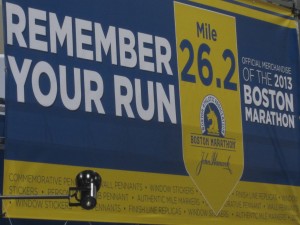 Recently, rumors have flooded news feeds that the Boston Marathon is considering expanding the field by 9000 runners for the April 2014 race. Some people view this news as great, while others don’t want to see the race expand. I have considered in past weeks to blog about the constantly growing fields in marathons. On the heels of this recent Boston Marathon news, it seems like a good time to discuss this topic.
Recently, rumors have flooded news feeds that the Boston Marathon is considering expanding the field by 9000 runners for the April 2014 race. Some people view this news as great, while others don’t want to see the race expand. I have considered in past weeks to blog about the constantly growing fields in marathons. On the heels of this recent Boston Marathon news, it seems like a good time to discuss this topic.
Anyone who knows much about marathoning knows that the Boston Marathon is the only annual marathon that requires time qualifying performances in a previous marathon. It’s also the most famous marathon in the world. Achieving a BQ (Boston Qualifier) is always an honor, sometimes a dream come true, and not possible for many middle-of-the-pack runners. The quest and hard work to achieve a spot in this famous race is something special. Besides qualifying, the only other way into the Boston Marathon is to run and raise money for a charity.
As someone who has run Boston, I can tell you that the experience on race day, having earned a spot that I worked extremely hard for, filled me with extreme pride and emotion. After all, earning something always feels rewarding. If anyone understands that concept, it’s the marathoner. Charity runners work hard – they train AND raise money – no easy task. For the record, IF there are 9000 additional spots, it has not been revealed if those spots will be open to more qualifiers, charity runners, or a combination for the two.
In recent years, many of the big five marathons have been giving more and more spots to charities. In order to accommodate these growing charity spots, race organizers have either reduced the amount of spots for non-charity runners, or added additional spots – causing race numbers to grow at a rapid pace. Charity spots often require a financial commitment of $2500-$5000 per marathon, with a percent going to the charity of choice and a percent (larger than most runners are aware!) going to the race organization. Yes, charities are incredibly profitable for race organizations. Don’t get me wrong, race organizations need to make a profit, and charities can be a great cause – but in future years will there be any spots left for non-charity, non-elite marathoners? The London Marathon is virtually impossible to get a spot in unless you run for a charity. It won’t be long before other organizations follow suit. I wonder if in the future runners will be able to acquire marathon spots without an elite status or a charity?
For many runners, signing up with a charity is a way fulfill a dream of running a marathon they may otherwise never be able to run. For example, the New York City Marathon, despite its massive race field (over 40,000 runners!) is next to impossible to get into through the lottery. Running for a charity may mean the ability to run the NYCM, or the Boston Marathon while never running close to a BQ.
My question: how much bigger can these big city marathons possibly get? Many are already bursting at the seams, barely able to accommodate the number of runners, and stressing the resources of the host cities. When is it enough? In the aftermath of the 2013 Boston Marathon, security will be a huge concern at all of the big city marathons in future years.
It’s a wonderful thing that more people than ever are lacing up and training for marathons. What isn’t wonderful is the sense of entitlement that plagues the running community. After all, we runners take over cities for an entire weekend without much of a thought regarding how we affect the town or city we take over for the race. Perhaps it’s okay for there to be some marathons that aren’t for the “average Joe.” Frankly, I’m an “average Joe,” and shouldn’t be able to qualify for every race. Personally, if I could be qualified to run 90 out of 100 of annual marathons, and that meant we could all have a better experience, and reduce the stress on host cities, the medical and security resources – I’d be totally okay with that. And if I wanted to qualify for those remaining 10 – I’d train my butt off and set that as a goal.
I suppose what I am trying to address in this blog is the growth of the marathon, the stress on the host cities, and where is the future of marathon going? Obviously every race is as different as the course the runners travel from start to finish. Each city and race organization is different. My hope is that marathons stop becoming over-crowded (for safety reasons and for the sheer enjoyment of the runners!), and that the financial incentives for race organizations doesn’t trump the race experience and safety issues.
I hope that unless they come up with some genius plan, the BAA won’t change the number of participants for 2014. The race from Hopkinton to Boston is on a road that realistically isn’t big enough to handle an additional 9000 runners – unless they add a fourth wave, perhaps? Part of the charm of the race is the journey through the Boston suburbs, as locals cheer, hand out water and offer high-fives. This past year, there were still spots open for qualifiers after the registration dates past – meaning that EVERY runner who had planned a qualifying time by the registration date got their spot – and registration stayed open for an additional week! Therefore, is it necessary or smart to change the iconic Boston Marathon in order to accommodate an additional 9000 runners?
I understand how financially enticing an additional 9000 runners could be – especially if those go to charity spots. And I also understand how runners all across the world, speedsters and average-Joe’s alike felt this past year’s tragedy pull at their heartstrings. I get it. But I also hold the Boston Marathon in my heart as a very special race, a race that is somewhat exclusive, and a privilege that is earned. After all, it’s the Boston Marathon.




